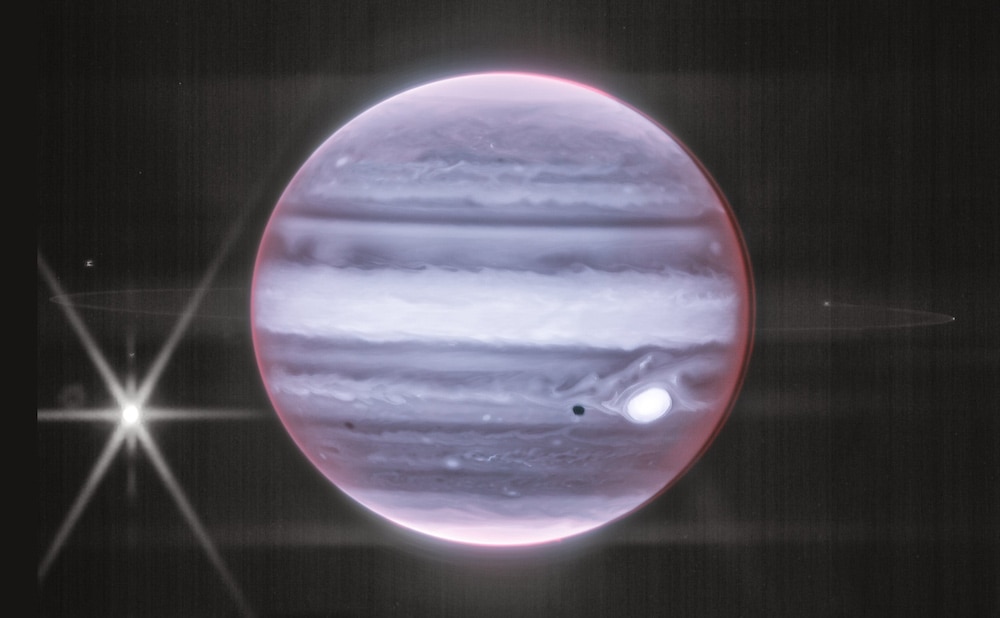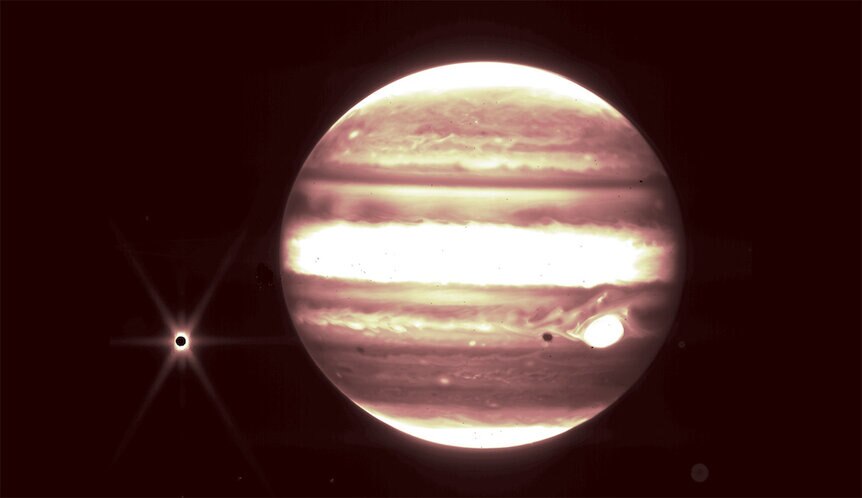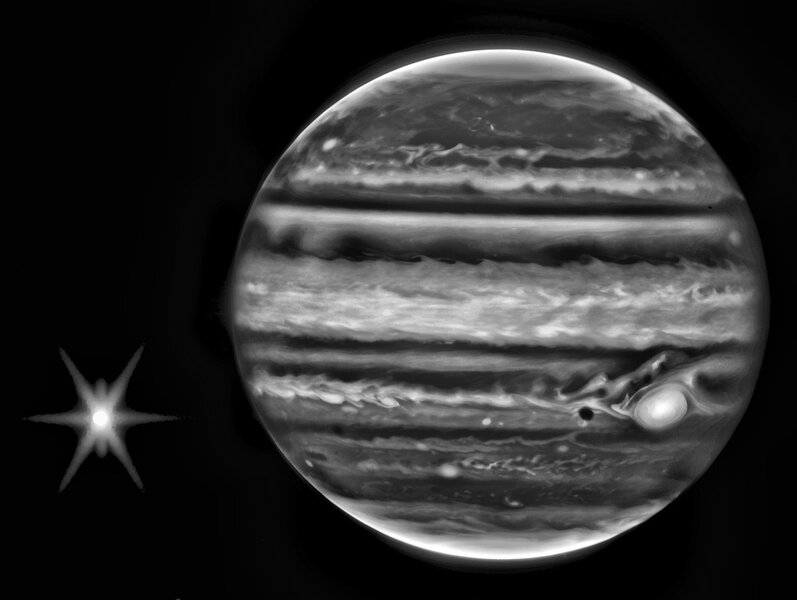Create a free profile to get unlimited access to exclusive videos, sweepstakes, and more!
JWST: Jupiter watched by a space telescope
The king of the planets looks spectacular in infrared.

On July 12, 2022, the first images and spectra from JWST were released, and were absolutely spectacular. Galaxies, stars, nebulae, and even observations of the atmosphere of a distant exoplanet — all incredible, and all just a hint at what the space-based observatory will do in the coming years.
But even before those images were released astronomers and engineers were busily running JWST through a series of tests, including seeing how well it could track objects. JWST is in an Earth-like orbit around the Sun, so deep-space objects only appear to move about 1° per day (360° around the Sun in a year divided by 365 days per year). That’s not too hard.
But solar system objects move much faster. For one thing they orbit the Sun, so they move against the background stars, plus the Earth — and therefore JWST — also orbit faster than the outer planets, so that adds to their motion*. JWST needs to be able to track these targets if astronomers can hope to observe them.
To test its capabilities, they ordered JWST to point to the King of the Planets, Jupiter. And why not: it’s big and bright, so exposures can be short, and moves more rapidly than the other outer planets, so if JWST can track it, then we’re all set.
These engineering test images weren’t released with the others, but were made public in the data archive. A lot of different people pounced on them, using their skills to create images from the data. And oh my, the results. Oh, my.
First, here is the “official” image taken by the Near-Infrared Camera, or NIRCAM, on JWST.
Whoa.
This was taken using a 2.12 micron filter, which selects light with wavelengths about 2-3 times what the human eye can see. This particular filter lets through a very narrow range of wavelengths, which is advantageous when looking at something as bright as Jupiter; it cuts out a lot of light that would otherwise overwhelm the camera. Cold molecular hydrogen — two hydrogen atoms bonded together, called H2 — emits light at this wavelength, so the filter is useful for looking at star formation regions in galaxies.
That image has been cleaned considerably. The raw images were not observed to make pretty pictures but instead to help commission the telescope. So, for example, you can see black dots on Jupiter that are pixels in the detector that aren’t calibrated correctly. The bright object on the left is Jupiter’s moon Europa, which was so bright it saturated the detectors, flooding it so hard the center region is black — think of it a bit like trying to fill a bucket with a fire hose, with most of the water splashing out. That’s not an exact analogy, but close enough.
You can see a lot of familiar structure in Jupiter’s cloud tops, including the broad stripes. However, this image is in the infrared, so things look different. The Great Red Spot, for example, emits a lot of light at 2.12 microns, so it appears very bright, as do several of the broad bands. The poles, which normally appear dark in visible light, are bright here. These differences between what we see in visible and infrared light tell planetary scientists about conditions in Jupiter’s clouds, which will help them understand the complex chemistry and behavior of these structures.
So: The image is functional and pretty cool. But then some folks who love to play with space telescope images got their hands on the data, and yeGADS.
That image was processed by Ian Regan, who has a long history of working with space-based data. He cleaned the data up, and applied various techniques to bring out details. Far more structure can be seen in the planet’s atmosphere, as well as the shadow of Europa just to the left of the Great Red Spot. Lovely.
Judy Schmidt, whose name may be familiar to regular readers because I have written about her work many times before, also processed the data, but did something different, creating a color image from three different filters, and the results are simply jaw-dropping:
Holy yikes. The 2.12 micron filter image is displayed here as blue, and she used a combination of two filters — a 3.22 micron filter that allows in light from a wide range of wavelengths, and a 3.23 micron filter with a much narrower bandpass — to create the red layer.
Besides adding color, her images have the contrast stretched way up, which reveals two highly remarkable features.
The first is Jupiter’s ring! You can see it as a thin elliptical arc on the right and left of the planet itself. Although not as glorious and gaudy as Saturn’s magnificent rings, Jupiter’s main ring was discovered in 1979 when Voyager flew past the giant planet. Fainter rings were found later. The main ring is mostly dust, unlike Saturn’s which are nearly pure water ice. On the right side of Jupiter you can also see two bright spots in the ring; those are the tiny moons Metis and Adrastrea, whose gravity helps keep the dust particles entrained in the narrow ring, and may also be a source of that very dust. The faint glow above Europa on the left is the moon Thebe, by the way.
Seeing the ring was a surprise, but not nearly as big of one as the bright arc on the right of Jupiter, just outside the curved edge of the planet itself!
It’s not clear what that is. It might be an artifact of the camera observing such a bright planet, like an internal reflection. But if so you’d expect it to show up as a solid disk, not a narrow arc. Many planetary scientists think it may instead be real: A haze layer of particles suspended high above the cloud tops. The sunlight is coming in slightly from the left in this image, so it’s possible it’s illuminating a thin layer in the upper atmosphere. If so, this is yet another free bonus JWST has provided scientists, a gift no one was expecting.
And this hints at glories yet to come. JWST has a full schedule, observing objects from inside the solar system to quite literally the edge of the observable Universe. And it’s just getting started.
Just you wait. A lot more is coming. A lot.
* JWST is not allowed to look at Venus or Mercury, which are too close to the Sun in the sky. The observatory is designed to keep sunlight away to avoid heating the instruments and mirrors, which operate at temperatures close to absolute zero. Because of this it can only observe solar system objects outside Earth’s orbit.





























